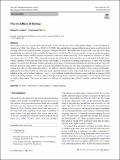The Iris Effect: A Review
Author(s)
Lindzen, Richard S; Choi, Yong-Sang
Download13143_2021_Article_238.pdf (747.1Kb)
Publisher Policy
Publisher Policy
Article is made available in accordance with the publisher's policy and may be subject to US copyright law. Please refer to the publisher's site for terms of use.
Terms of use
Metadata
Show full item recordAbstract
Abstract
This study reviews the research of the past 20-years on the role of anvil cirrus in the Earth’s climate – research initiated by Lindzen et al. (Bull. Am. Meteor. Soc. 82:417-432, 2001). The original study suggested that the anvil cirrus would shrink with warming, which was estimated to induce longwave cooling for the Earth. This is referred to as the iris effect since the areal change hypothetically resembles the light control by the human eye’s iris. If the effect is strong enough, it exerts a significant negative climate feedback which stabilizes tropical temperatures and limits climate sensitivity. Initial responses to Lindzen et al. (Bull. Am. Meteor. Soc. 82:417-432, 2001) denied the existence and effectiveness of the iris effect. Assessment of the debatable issues in these responses will be presented later in this review paper. At this point, the strong areal reduction of cirrus with warming appears very clearly in both climate models and satellite observations. Current studies found that the iris effect may not only come from the decreased cirrus outflow due to increased precipitation efficiency, but also from concentration of cumulus cores over warmer areas (the so-called aggregation effect). Yet, different opinions remain as to the radiative effect of cirrus clouds participating in the iris effect. For the iris effect to be most important, it must involve cirrus clouds that are not as opaque for visible radiation as they are for infrared radiation. However, current climate models often simulate cirrus clouds that are opaque in both visible and infrared radiation. This issue requires thorough examination as it seems to be opposed to conventional wisdom based on explicit observations. This paper was written in the hope of stimulating more effort to carefully evaluate these important issues.
Date issued
2021-04-01Department
Massachusetts Institute of Technology. Department of Earth, Atmospheric, and Planetary SciencesPublisher
Korean Meteorological Society